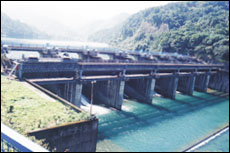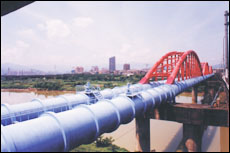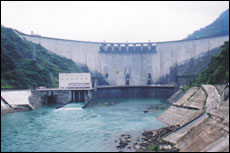Treatment of water is to make it potable or acceptable for other uses. Such treatment is of utmost importance today because of the rampant pollution of raw water at most known sources by industrial and household wastes as well as agricultural chemicals. Drinking untreated water can be hazardous to your health. It can even be lethal in more serious cases. This section will introduce to you the facilities and process of TWD’s water treatment and distribution system.
A. Water Source
The principal source of raw water that TWD collects is the Xindian Creek. It represents 97 % of total raw water supply. Other water sources, scattered in Taipei’s suburban mountain areas such as Yangmingshan, Shuanghsi, and Beitou, combine to constitute a mere 3%.
B. Raw Water Intake Facility
Two water intake units are in operation at the Xindian Creek. The Qingtan Dam takes in 1.08 million cubic meters of raw water daily, which is conveyed with gravity via a tunnel to the Zhangxing and Gongguan Purification Plants for treatment. The Zhitan Dam collects up to 2.70 million cubic meters a day. In a similar manner, water taken in there is transmitted to the Zhitan Purification Plant for treatment.
Eighteen smaller units installed at other sources also collect raw water. The Feitsui Reservoir, with a holding capacity of 406 million tons, has been providing the needed of raw water a day to Taipei metropolis since its start-up in June 1987.
C. Purification Plant
Raw water collected is firstly treated at one of TWD’s 5 purification plants- Changhxing, Gongguan, Zhitan, Shuangxi, and Yangming. Treatment process comprises of testing, applying chemical disinfectants, coagulation, mixing, sedimentation, and filtering.
D. Distribution Basin and Pumping Station
Points of water use served by TWD dot every nook and corner of the Taipei metropolis. Besides, water consumption levels vary widely from a place to another and from peak hours to off-peak period. Distribution basins are therefore required for adjusting delivery of treated water to meet demand properly. At the present, TWD has 92 such basins.
To enable water supply to reach the farthest ends of distribution piping system, in particular those at high altitudes, pumping stations have been set up by TWD at appropriate locations. New ones are installed as needed. Currently, TWD operates 60 pumping stations within its expansive service area.
E. Transmission and Distribution Piping Network
Over the years, TWD has placed a network of water pipes, with a caliber ranging from 75 mm to 3,400 mm, that add up to a total length over 3,000 km. To balance water pressure and reduce leakage, a water supply monitoring and control system was instituted in June 1991 for better control of pressure changes in the distribution system, for flexible adjustment of water supplies, and for early detection and prevention of accidents.
F. Sludge Treatment Facility
Wastes discharged from water purification process, including settled flocculating waste and filter backwash waste, can contaminate water sources. So they must be treated before disposal. After 3 years of construction, a sludge treatment facility was set up at the Zhitan Purification Plant and commenced operation in June 1993. At present, Gongguan Purification Plant has its own sludge treatment facility as well, Zhangxing, Shuangxi and Yangming sent their sludge to Gongguan Purification Plant to process.
G. Taipei Water Supply Expansion Plan, Phase V
All municipalities around the world must manage to satisfy an ever more demand for water supply for household, commercial, industrial, agricultural, municipal, fire-fighting, and other uses. Taipei is a case in point. Four previous phases of the Taipei Water Supply Expansion Plan, completed respectively in 1965, 1971, 1977, and 1991, have carried Taipei through. Since 1991, TWD has been actively executing the 5th phase of Taipei Water Supply Expansion Plan to meet the forecasted water demand for the year 2030. Stage 1 works of the Phase has been completed, which comprise:
The No. 4 and No.5 purification facility at Zhitan, with a daily processing capacity of 500,000 and 700,000 cubic meters respectively, has already been completed and commenced operation;
The No. 2 clean water transmission mains and its 4 branch lines have been completed. With all works of the Stage 1 carried out, we have seen a tremendous upgrade of TWD's water supply capability.



Water Treatment and Distribution System
A. Water efficiency policy
1. Promoting efficacy in water resource utilization
2. Enhancing ability to lower high turbidity caused by heavy rainfall
3. Strengthening water supply facilities
4. Establishing emergency life-supporting water supply stations
5. Initiating green water supply program
B. Water pressure management
Install converted frequency facilities in booster stations to optimize supply pressure and lower system leakage. Two of the water mains had already saved 15% of daily water delivered while maintaining minimum pressure to those users located at the far end of the system.
C. Water efficiency initiatives
1. From 2003 to 2025, USD 800 million will be invested in pipeline network improvement to reduce leak rate by 1% per year. The ultimate goal is to reduce leak rate to as low as 10% in 2025.
2. Promoting household water saving Initiatives to lower household water consumption: (a) 2003~ Rolled out initiatives for household water saving; (b) 2007~2009: Distributing water-saving kits to 1.3 million users over 3 years based on consumption from high to low and is expected to save 3% of total consumption ( 2008 saved total 12.30 million tons, a reduction of 2.05%; 2009 saved total 14.57 million tons, a reduction of 2.43%; Jan- Jul 2010 saved 10.71 million tons, a reduction of 1.79%); (c) 2011~2013: Encourage users to replace old toilets with dual-flush-toilets.
D. Water efficiency promotion
1. Publish and distribute water resource manual as an auxiliary teaching material for school children since 2005 and issued e-book manual instead since 2009.
2. Install solar power facilities and build a new water resource education center in Gongguan purification plant to enforce water saving concept and practices.

![Taiwan.gov.tw [ open a new window]](/images/egov.png)
